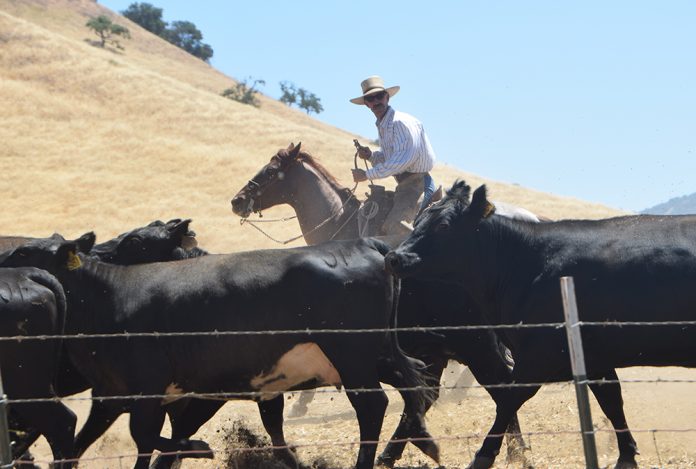
From San Jose south down U.S. 101, most folks who live in the valley have little idea what happens in the hills that surround them. The rolling hills are full of life, though, and the cattle industry practiced since the Spanish Vaqueros still thrives.
Mostly unseen, the work done on surrounding cattle ranches shows up on our dinner plates and through the veins of the regional agricultural economy—33,500 head of cattle in San Benito County and 13,300 head in Santa Clara County, according to the 2016 USDA Agricultural Census.
One of those ranchers is Justin Fields, president of the Santa Clara County Cattleman’s Association, who works alongside his wife, Arleah Fields, and daughters Jenna,17, a senior at Sobrato High School who’s heading to Cal-Poly San Luis Obispo in the fall, and Jodi,13, to ranch almost 500 head of cattle. Fields is tall, with blue eyes and a neat pushbroom mustache, and he’s a real-life cowboy, with the chaps, spurs, rodeo belts and family heritage to prove it. Still, when he comes to town to pick up his daughter from school, people often can’t understand what he does.
“They are so removed from the land, they don’t know where their food comes from,” Fields, 46, said. “They don’t realize that their food is actually being produced here.”
The Fields’ ranch is one of the few remaining family-owned cattle ranches in Santa Clara County. The Fields own 700 acres of prime grassland in the rolling hills of Coyote Valley, just south of San Jose. To accommodate almost 500 head of cattle, they lease an additional 7,000 acres, much of it on public lands administered by the Santa Clara County Open Space Authority.
“In this area, there aren’t many family-owned ranches,” Fields said. “It’s rare that a rancher owns enough property where they don’t need to lease more acreage to run their cows.”
The end of May is the culmination of a year’s worth of work, and last Friday was the final send-off for 32 cows and 14 calves—Herefords and Angus—which Fields loaded into the back of a semi-trailer to be sent to auction. He had some help. With fellow rancher Pierre Paquelier, and Arleah on horseback, they led the cattle through a chute. As the team loaded the cattle, mother cows bellowed for recently weaned and now separated calves.
“They’re still looking for their calves; they’re agitated, mooing and bawling,” Fields said. “It’s kind of sad, but it happens every year. That’s the annual cycle.”
It’s an annual process that ranchers have repeated, in differing ways, since the Spanish Rancheros established land grants in the 1700s. At the Fields Ranch, the end of May is payday. This year the rate is about $1.55 a pound, or about $1,007 a head at the video auction. Of course, when your payday comes once a year, you need to be able to budget well.
“I brought in our check to the bank, and while I waited the bank manager came out to ask us about investing our money,” Arleah Fields said. “When I told him that was our paycheck for the year, he was like ‘Oh, wow.’ ”
The video market has modernized the old school auction. Via a satellite link, faraway buyers bid for whole truckloads of preloaded cattle by video. The prospective buyers are given necessary information like weight, breeds and vaccination background to bid on truckloads of cattle weighing close to 50,000 pounds.
“You need to budget everything,” Fields said. “The biggest expense is leasing land, which can range from $10 to $20 per acre, or by a per head per month basis which is between $15 to $20 depending on which agency you deal with. When you pay for a mother cow, you are paying for the calf as well.”
On average it takes 10 acres of property to support a cow for one year, depending on the land. Aside from the calving season in the fall, cattle can take care of themselves while out on the ranch. Still, the Fields ride their land looking for potential trouble, like a sick cow, or they check on water and fences. They also work to rotate grazing land, especially during the winter and spring when the grass is still growing. In this case, the cows act as lawn mowers.
The market for beef is bullish. In January, Bloomberg reported that in 2018 the average American is expected to eat 222.2 pounds of red meat and poultry, and that domestic beef production will exceed 100 billion pounds. In the international market, U.S. beef producers exported over $7 billion in beef products, with Japan as the largest consumer at $1.9 billion. The Chinese marketplace, which had been cut off since 2003, was reopened in last year after the U.S.-China Comprehensive Economic Dialogue in June.
Among the challenges of running a cattle ranch, the weather is always a big one. While the Fields have a few water wells operated by solar-powered pumps, most of the water they use is spring water. However, during the worst parts of the drought that ended in the winter of 2016, water from the City of San Jose proved invaluable.
The Fields Ranch is the definition of a family-owned and -operated outfit. Justin, Arleah, their two daughters, nine horses and a team of cattle dogs make the operation work. There is also a strong sense of community among ranchers, where a handshake is still bonding. On June 1, fellow rancher Paquelier was there to help, and Fields will return the favor in kind. When the margins are so razor thin, the community helps family farms survive.









